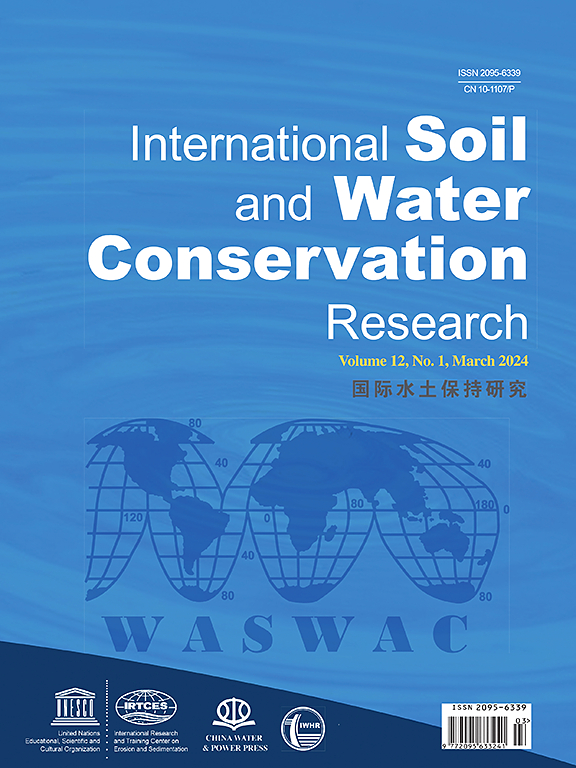Incorporating rocky desertification characteristic into soil erosion modeling in karst regions aligns better with regional conditions
IF 7.3
1区 农林科学
Q1 ENVIRONMENTAL SCIENCES
International Soil and Water Conservation Research
Pub Date : 2025-07-09
DOI:10.1016/j.iswcr.2025.07.004
引用次数: 0
Abstract
The Revised Universal Soil Loss Equation (RUSLE) is the most widely used soil erosion modeling method worldwide. The karst regions, influenced by geological conditions and human activities, feature extensive exposure of carbonate rocks on the surface, which presents challenges for the application of the RUSLE model in these areas. This study introduces the rocky desertification factor (D) to characterize the influence of exposed surface rock on soil loss. The relationship between rock exposure rate and soil erosion was incorporated into the RUSLE model to develop a RUSLE-D model. We compared the performance of the RUSLE and RUSLE-D models using long-term high-frequency hydrological signals from two typical karst catchments to validate the applicability of the RUSLE-D model in karst areas. The results indicated that under natural rainfall conditions, soil erosion decreased as the rock exposure rate increased, showing a negative exponential relationship. The RUSLE-D model estimated the multi-year average soil erosion rates for the SBT and GC catchments to be 8.99 and 14.63 t ha−2·yr−1, respectively. The R2 values for the RUSLE and RUSLE-D models in the SBT catchment were 0.34 and 0.78, respectively, with NSE values of −0.03 and 0.55, and PBIAS values of −81.39 % and 13.87 %; for the GC catchment, the R2 values were 0.14 and 0.68, with NSE values of −13.82 and 0.43, and PBIAS values of −182.85 % and −24.27 %. The MCI indices for the SBT and GC catchments were 0.56 and 0.96, respectively. The RUSLE-D model significantly improved the accuracy of soil erosion simulation in typical karst watersheds. This study underscores the importance of incorporating the rocky desertification factor in soil erosion assessments within karst areas. The newly developed RUSLE-D model contributes to further developing the USLE/RUSLE series of models, enhancing their applicability in karst areas.
将石漠化特征纳入喀斯特地区土壤侵蚀模型更符合区域实际
修正通用土壤流失方程(RUSLE)是目前国际上应用最广泛的土壤侵蚀模型方法。岩溶地区受地质条件和人类活动的影响,地表大量暴露碳酸盐岩,这给RUSLE模型在岩溶地区的应用带来了挑战。本文引入石漠化因子(D)来表征地表裸露岩石对土壤流失的影响。将岩石暴露率与土壤侵蚀的关系纳入RUSLE模型,建立RUSLE- d模型。利用两个典型喀斯特流域的长期高频水文信号,对比RUSLE和RUSLE- d模型的性能,验证RUSLE- d模型在喀斯特地区的适用性。结果表明:在自然降雨条件下,土壤侵蚀随岩石暴露率的增加而减小,呈负指数关系;RUSLE-D模型估计SBT和GC流域的多年平均土壤侵蚀速率分别为8.99和14.63 t ha - 2·yr - 1。SBT流域RUSLE和RUSLE- d模型的R2分别为0.34和0.78,NSE分别为- 0.03和0.55,PBIAS分别为- 81.39%和13.87%;GC流域的R2分别为0.14和0.68,NSE分别为- 13.82和0.43,PBIAS分别为- 182.85%和- 24.27%。SBT流域和GC流域的MCI指数分别为0.56和0.96。RUSLE-D模型显著提高了典型喀斯特流域土壤侵蚀模拟的精度。本研究强调了将石漠化因素纳入喀斯特地区土壤侵蚀评价的重要性。新建立的RUSLE- d模型有助于进一步发展USLE/RUSLE系列模型,增强其在喀斯特地区的适用性。
本文章由计算机程序翻译,如有差异,请以英文原文为准。
求助全文
约1分钟内获得全文
求助全文
来源期刊

International Soil and Water Conservation Research
Agricultural and Biological Sciences-Agronomy and Crop Science
CiteScore
12.00
自引率
3.10%
发文量
171
审稿时长
49 days
期刊介绍:
The International Soil and Water Conservation Research (ISWCR), the official journal of World Association of Soil and Water Conservation (WASWAC) http://www.waswac.org, is a multidisciplinary journal of soil and water conservation research, practice, policy, and perspectives. It aims to disseminate new knowledge and promote the practice of soil and water conservation.
The scope of International Soil and Water Conservation Research includes research, strategies, and technologies for prediction, prevention, and protection of soil and water resources. It deals with identification, characterization, and modeling; dynamic monitoring and evaluation; assessment and management of conservation practice and creation and implementation of quality standards.
Examples of appropriate topical areas include (but are not limited to):
• Conservation models, tools, and technologies
• Conservation agricultural
• Soil health resources, indicators, assessment, and management
• Land degradation
• Sustainable development
• Soil erosion and its control
• Soil erosion processes
• Water resources assessment and management
• Watershed management
• Soil erosion models
• Literature review on topics related soil and water conservation research
 求助内容:
求助内容: 应助结果提醒方式:
应助结果提醒方式:


